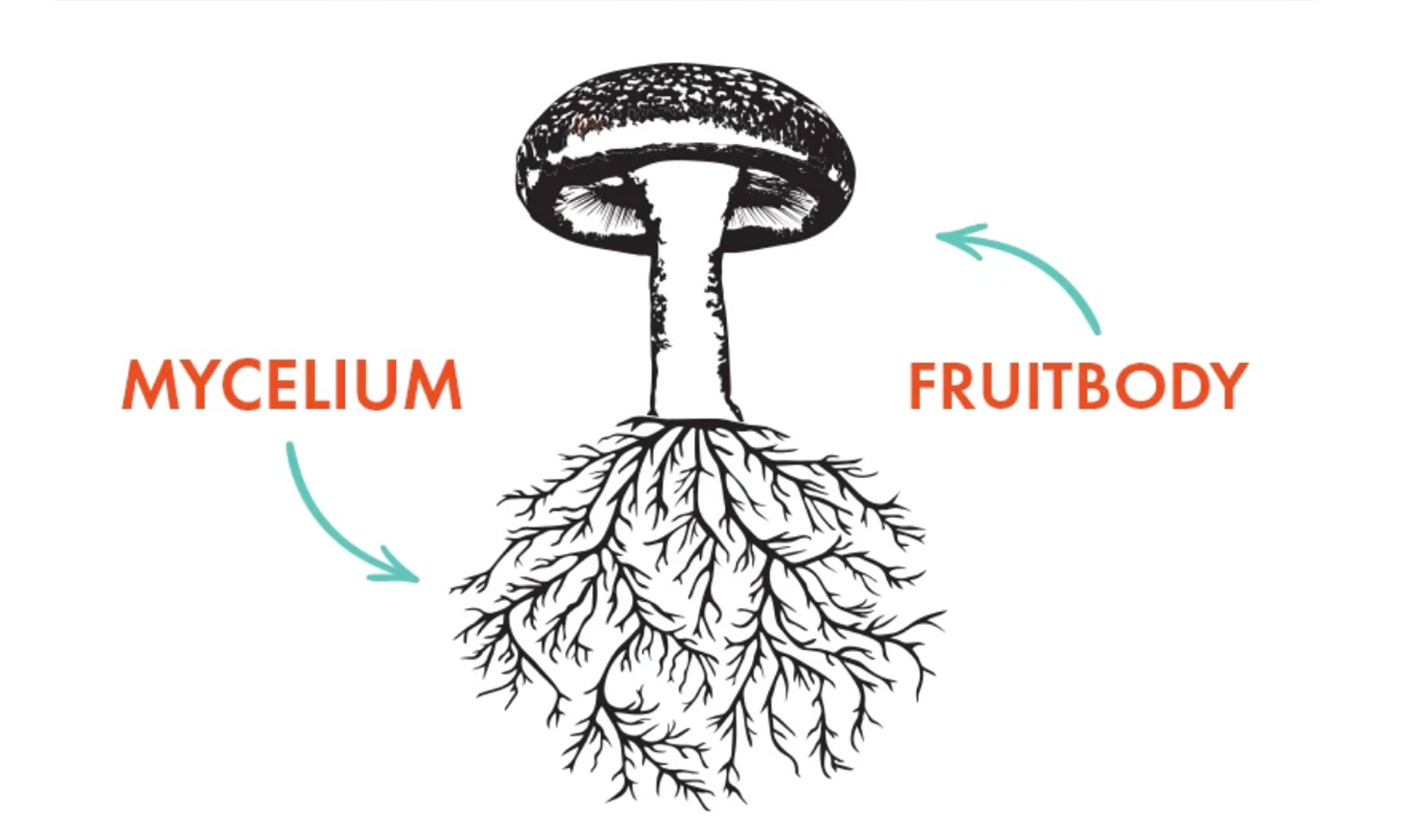Medicinal Mushrooms - Part 1
What are Mushrooms?
Until relatively recently (1969), mushrooms (a.k.a fungi) were considered close enough to the plant family that they were lumped in together. Still today, the language we use to describe parts of the mushroom is very plant-like. But…they’re actually more similar to animals than plants (wow!). They’re now in their own category of “Fungi”.
Here’s an overview of the parts of a mushroom:
Fruiting body = the mushroom you pick or buy at the grocery store
Seeds = the spores mushrooms release to “seed” themselves elsewhere
Mycelium = the root-like structure that lives underground or inside wood (dead log or tree), this is the main ‘body’ of the mushroom/fungi.
We tend to think about the fruiting body as the main part of the fungi, but that’s a mistake. The visible mushroom is like an apple on an apple tree. It’s important, but only a small part of the whole tree.
The mycelium, which lives underground, is the real story of the fungi. The largest organism in the world is a fungus that lives in the pacific northwest. Dwarfing the largest whale and older than the oldest cedar tree, a honey mushroom in Oregon spans 2200 acres and is somewhere between 2400 to 8600 years old!
The magic of the mushroom happens in the mycelium. We’re beginning to learn that the mycelium act as the conductors of the environment. Steering it and guiding forests and meadows over centuries.
It’s being called the “wood wide web”, the mycelium can be found under every lawn, forest, and field. They connect trees and help them share nutrients. They digest plant matter to make nutrient-rich soil.
We’re learning that about 90% of land plants are in a mutually beneficial relationship with mycelial networks. Without fungi - without mycelium - all ecosystems would fail.
Mushrooms are cool!
In a practical sense, mushrooms are more than just food and medicine. They may also be a huge resource in the future. They can also be used for textiles (like clothing), fibre, packaging material, and biofuel.
But, I think the most remarkable thing about mushrooms and fungi is how they support our forests and ecosystems and how they can be used to clean up ecological disasters.
Mushrooms are nutrient-dense, full of B vitamins, vitamin D, antioxidants, and potassium. But, honestly, that’s the least exciting part of the mushroom. What we’re going to be talking about is how their fibres and phytochemicals, like beta-glucans, glycosides, and phenols interact with the body.
Through mechanisms we only partially understand, mushrooms can modulate our immune system in ways that nothing else can. They can create person-specific antibiotics to fight disease. Yes, you read that right. You take certain medicinal mushrooms, they stimulate the immune system to make exactly the right antibiotic to fight off an offensive bacteria. This may combat antibiotic resistance in the future.
Insects have understood the power of mushrooms for much longer than humans have. Paul Stamets, a brilliant mushroom researcher, watched bees push back woodshavings to get at the mycelium of some mushrooms growing in his year. This observation triggered years of research where he found that mycelium of some mushrooms, including reishi and chaga, helps support the bee’s immune system. And, that VERY small doses can prevent the devastating colony collapse disorder. Stamets has since made this information public to allow everyone to benefit from this method to save bees.
I can’t get enough about mushrooms, even though I feel like I still barely understand them. They function so differently in the body than plants that I’m still getting my head around them. But…man, it’s so cool!
Want to learn more?
Here are a few great resources if you’d like to know more about these benefits of mushrooms:
Mushrooms in the forest and the “Wood Wide Web” (5mins)
https://www.youtube.com/watch?v=vYoRMT1szdU
6 Ways Mushrooms Can Save the World, TED talk with Paul Stamets (18mins)
https://www.youtube.com/watch?v=XI5frPV58tY
If you’d like to know more about this fascinating topic, check out the documentary Fantastic Fungi on Netflix
Fanstastic Fungi, Trailer (2min)
https://www.youtube.com/watch?v=bxABOiay6oA
Got any questions or comments? Comment below, jump to our private Facebook Group, or the Ask Lisa page :).

